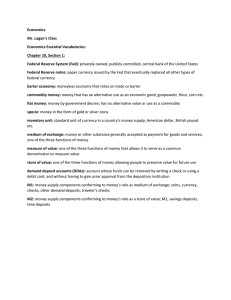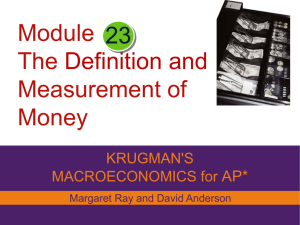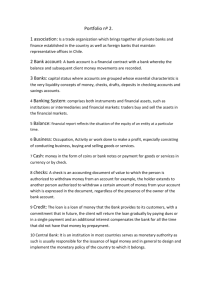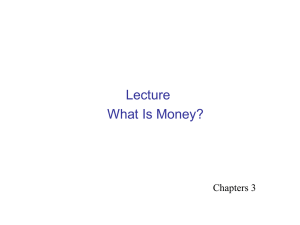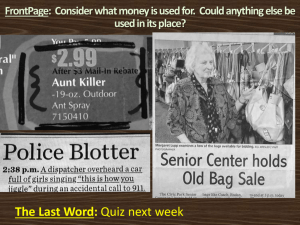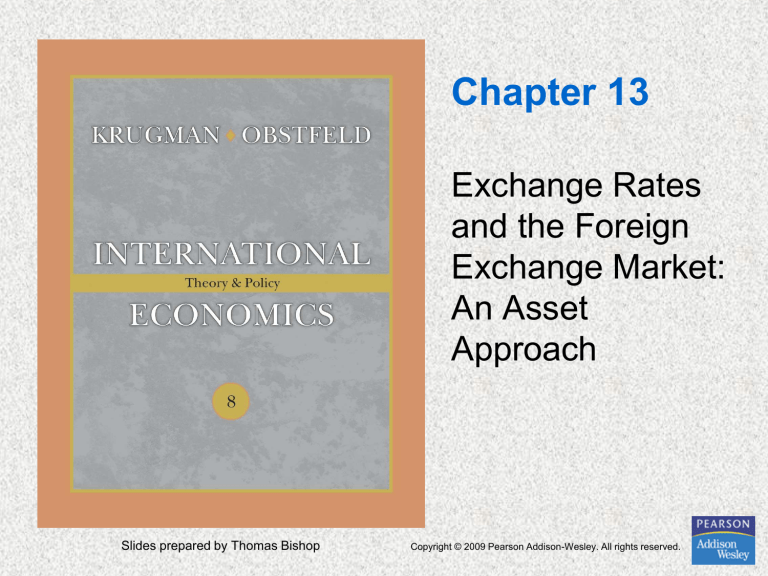
Chapter 13
Exchange Rates
and the Foreign
Exchange Market:
An Asset
Approach
Slides prepared by Thomas Bishop
Copyright © 2009 Pearson Addison-Wesley. All rights reserved.
Preview
• The basics of exchange rates
• Exchange rates and the prices of goods
• The foreign exchange markets
• The demand of currency and other assets
• A model of foreign exchange markets
role of interest rates on currency deposits
role of expectations of exchange rates
Copyright © 2009 Pearson Addison-Wesley. All rights reserved.
13-2
Definitions of Exchange Rates
• Exchange rates are quoted as foreign currency per unit of
domestic currency (Say USD/CAD) or domestic currency per
unit of foreign currency (CAD/USD).
• 1 CAD in other currencies:
• British Pound £ 0.503 GBP +0.0026 (0.525%) Euro € 0.636 EUR
+0.0042 (0.666%) Australian Dollar $ 1.221 AUD -0.0018 (0.144%) Japanese Yen ¥ 79.714 JPY -0.1342 (-0.168%) Swiss
Franc 0.934 CHF +0.0084 (0.908%) Indian Rupee 40.229 INR 0.4611 (-1.133%)
• (http://finance.google.ca/finance?q=CADUSD)
• Exchange rates allow us to denominate the cost or price of a
good or service in a common currency.
How much does a Honda cost? ¥3,000,000
Or, ¥3,000,000 x $0.0098/¥1 = $29,400
Copyright © 2009 Pearson Addison-Wesley. All rights reserved.
13-3
Depreciation and Appreciation
• Depreciation is a decrease in the value of a
currency relative to another currency.
A depreciated currency is less valuable (less
expensive) and therefore can be exchanged for
(can buy) a smaller amount of foreign currency.
$1/€1 → $1.20/€1 means that the dollar has
depreciated relative to the euro. It now takes $1.20
to buy one euro, so that the dollar is less valuable.
The euro has appreciated relative to the dollar:
it is now more valuable.
Copyright © 2009 Pearson Addison-Wesley. All rights reserved.
13-4
Depreciation and Appreciation (cont.)
• Appreciation is an increase in the value of a
currency relative to another currency.
An appreciated currency is more valuable (more
expensive) and therefore can be exchanged for
(can buy) a larger amount of foreign currency.
$1/€1 → $0.90/€1 means that the dollar has
appreciated relative to the euro. It now takes
only $0.90 to buy one euro, so that the dollar is
more valuable.
The euro has depreciated relative to the dollar:
it is now less valuable.
Copyright © 2009 Pearson Addison-Wesley. All rights reserved.
13-5
Depreciation and Appreciation (cont.)
• A depreciated currency is less valuable, and therefore
it can buy fewer foreign produced goods that are
denominated in foreign currency.
How much does a Honda cost? ¥3,000,000
¥3,000,000 x $0.0098/¥1 = $29,400
¥3,000,000 x $0.0100/¥1 = $30,000
• A depreciated currency means that imports are more
expensive and domestically produced goods and
exports are less expensive.
• A depreciated currency lowers the price of exports
relative to the price of imports.
Copyright © 2009 Pearson Addison-Wesley. All rights reserved.
13-6
Depreciation and Appreciation (cont.)
• An appreciated currency is more valuable, and
therefore it can buy more foreign produced goods that
are denominated in foreign currency.
How much does a Honda cost? ¥3,000,000
¥3,000,000 x $0.0098/¥1 = $29,400
¥3,000,000 x $0.0090/¥1 = $27,000
• An appreciated currency means that imports are less
expensive and domestically produced goods and
exports are more expensive.
• An appreciated currency raises the price of exports
relative to the price of imports.
• So say CAS depreciates, then how does it effect the
importers and exporters?
Copyright © 2009 Pearson Addison-Wesley. All rights reserved.
13-7
Foreign Exchange Markets
• The set of markets where foreign currencies
and other assets are exchanged for domestic
ones
Institutions buy and sell deposits of currencies or
other assets for investment purposes.
• The daily volume of foreign exchange
transactions was $1.9 trillion in 2004.
About 90% of transactions involved US dollars.
Copyright © 2009 Pearson Addison-Wesley. All rights reserved.
13-8
Foreign Exchange Markets
The participants:
1. Commercial banks and other depository
institutions: transactions involve buying/selling of
deposits in different currencies for investment
purposes.
2. Non-bank financial institutions (mutual funds,
hedge funds, securities firms, insurance companies,
pension funds) may buy/sell foreign assets for
investment.
3. Non-financial businesses conduct foreign currency
transactions to buy/sell goods, services and assets.
4. Central banks: conduct official international
reserves transactions.
Copyright © 2009 Pearson Addison-Wesley. All rights reserved.
13-9
Foreign Exchange Markets (cont.)
• Buying and selling in the foreign exchange
market are dominated by commercial and
investment banks.
Inter-bank transactions of deposits in foreign
currencies occur in amounts $1 million or more
per transaction.
Central banks sometimes intervene, but the direct
effects of their transactions are small and transitory
in many countries.
Copyright © 2009 Pearson Addison-Wesley. All rights reserved.
13-10
Foreign Exchange Markets (cont.)
• Computer and telecommunications technology
transmit information rapidly and have integrated
markets.
• The integration of markets implies that there is no
significant arbitrage between markets.
Arbitrage: buying at a low price and selling at a
high price for a profit.
• If dollars are cheaper in New York than in Hong Kong,
what do you predict will happen?
• When other factors are the same, people will buy assets
in New York and stop buying them in Hong Kong, so that
their price in New York rises and their price in Hong Kong
falls, until they are equal in the two markets.
Copyright © 2009 Pearson Addison-Wesley. All rights reserved.
13-11
One Arbitrage Case
• 1 USD = 0.7716 Euro
• 1 USD = 97.4900 Yen
• 1 Euro = 126.05 Yen
• Say if you have $1000, are you able to
make money based on the bid price
above?
Copyright © 2009 Pearson Addison-Wesley. All rights reserved.
13-12
• 1 USD = 0.7716 Euro
• 1 USD = 97.4900 Yen
• 1 Euro = 126.05 Yen
• 1USD= 97.49/126.05 Euro= 0.7734 Euro > 0.7716 Euro
• There exists arbitrage opportunities.
• How do we make use of it?
• Buy low and sell high!
• Buy 97.49 X 1000 =97,490 Yen using 1000 USD.
• Buy 97,490 /126.05 = 773.4 Euro using 97,490 Yen.
• Buy 773.4 /0.7716 = 1002.33 USD > 1000 USD (Cost)
• Profit = 1002.33-1000=2.33 USD
Copyright © 2009 Pearson Addison-Wesley. All rights reserved.
13-13
Spot Rates and Forward Rates
• Spot rates are exchange rates for currency
exchanges “on the spot”, or when trading is
executed in the present.
• Forward rates are exchange rates for
currency exchanges that will occur at a future
(“forward”) date.
Forward dates are typically 30, 90, 180, or 360
days in the future.
Rates are negotiated between two parties in the
present, but the exchange occurs in the future.
Copyright © 2009 Pearson Addison-Wesley. All rights reserved.
13-14
Fig. 13-1: Dollar/Pound Spot and Forward
Exchange Rates, 1981–2007
Source: Datastream. Rates shown are 90-day forward exchange rates and spot exchange rates, at end of month.
Copyright © 2009 Pearson Addison-Wesley. All rights reserved.
13-15
Other Methods of Currency Exchange
• Foreign exchange swaps: a combination of a spot
sale with a forward repurchase.
Swaps often result in lower fees or transactions costs
because they combine two transactions, and they allow
parties to meet each others needs for a temporary amount of
time.
• Futures contracts: a contract designed by a third
party for a standard amount of foreign currency
delivered/received on a standard date.
Contracts can be bought and sold in markets, and only the
current owner is obliged to fulfill the contract.
Copyright © 2009 Pearson Addison-Wesley. All rights reserved.
13-16
Other Methods of Currency Exchange
• Options contracts: a contract designed by a
third party for a standard amount of foreign
currency delivered/received on or before a
standard date.
Contracts can be bought and sold in markets.
A contract gives the owner the option, but not
obligation, of buying or selling currency if the
need arises.
Copyright © 2009 Pearson Addison-Wesley. All rights reserved.
13-17
The Demand of Currency Deposits
• What influences the demand of (willingness to
buy) deposits denominated in domestic or
foreign currency?
• Factors that influence the return on assets
determine the demand of those assets.
Copyright © 2009 Pearson Addison-Wesley. All rights reserved.
13-18
The Demand of Currency Deposits (cont.)
• Rate of return: the percentage change in value that
an asset offers during a time period.
The annual return for $100 savings deposit with an interest
rate of 2% is $100 x 1.02 = $102, so that the rate of return =
($102 - $100)/$100 = 2%
• Real rate of return: inflation-adjusted rate of return,
which represents the additional amount of goods & services
that can be purchased with earnings from the asset.
The real rate of return for the above savings deposit when
inflation is 1.5% is: 2% – 1.5% = 0.5%. After accounting for
the rise in the prices of goods and services, the asset can
purchase 0.5% more goods and services after 1 year.
Copyright © 2009 Pearson Addison-Wesley. All rights reserved.
13-19
The Demand of Currency Deposits (cont.)
• If prices are fixed, the inflation rate is 0% and
(nominal) rates of return = real rates of return.
• Because trading of deposits in different
currencies occurs on a daily basis, we often
assume that prices do not change from day to
day.
A good assumption to make for the short run.
Copyright © 2009 Pearson Addison-Wesley. All rights reserved.
13-20
The Demand of Currency Deposits (cont.)
• Risk of holding assets also influences decisions
about whether to buy them.
• Liquidity of an asset, or ease of using the asset to
buy goods and services, also influences the
willingness to buy assets.
• But we assume that risk and liquidity of currency
deposits in foreign exchange markets are essentially
the same, regardless of their currency denomination.
Risk and liquidity are only of secondary importance when
deciding to buy or sell currency deposits.
Importers and exporters may be concerned about risk and
liquidity, but they make up a small fraction of the market.
Copyright © 2009 Pearson Addison-Wesley. All rights reserved.
13-21
The Demand of Currency Deposits (cont.)
• We therefore say that investors are primarily
concerned about the rates of return on
currency deposits.
• Rates of return that investors expect to earn
are determined by
interest rates that the assets will earn
expectations about appreciation or depreciation
Copyright © 2009 Pearson Addison-Wesley. All rights reserved.
13-22
The Demand of Currency Deposits (cont.)
• A currency deposit’s interest rate is the amount of a
currency that an individual or institution can earn by
lending a unit of the currency for a year.
• The rate of return for a deposit in domestic currency
is the interest rate that the deposit earns.
• To compare the rate of return on a deposit in
domestic currency with one in foreign currency,
consider
the interest rate for the foreign currency deposit
the expected rate of appreciation or depreciation of the
foreign currency relative to the domestic currency.
Copyright © 2009 Pearson Addison-Wesley. All rights reserved.
13-23
The Demand of Currency Deposits (cont.)
• Suppose the interest rate on a dollar deposit is 2%.
• Suppose the interest rate on a euro deposit is 4%.
• Does a euro deposit yield a higher expected rate
of return?
Suppose today the exchange rate is $1/€1, and the expected
rate one year in the future is $0.97/€1.
$100 can be exchanged today for €100.
These €100 will yield €104 after one year.
These €104 are expected to be worth $0.97/€1 x €104 =
$100.88 in one year.
Copyright © 2009 Pearson Addison-Wesley. All rights reserved.
13-24
The Demand of Currency Deposits (cont.)
• The rate of return in terms of dollars from investing in
euro deposits is ($100.88-$100)/$100 = 0.88%.
• Let’s compare this rate of return with the rate of return
from a dollar deposit.
The rate of return is simply the interest rate.
After 1 year the $100 is expected to yield $102:
($102-$100)/$100 = 2%
• The euro deposit has a lower expected rate of return:
thus, all investors should be willing to dollar deposits
and none should be willing to hold euro deposits.
Copyright © 2009 Pearson Addison-Wesley. All rights reserved.
13-25
The Demand of Currency Deposits (cont.)
• Note that the expected rate of appreciation of
the euro was ($0.97- $1)/$1 = -0.03 = -3%.
• We simplify the analysis by saying that the
dollar rate of return on euro deposits
approximately equals
the interest rate on euro deposits
plus the expected rate of appreciation of euro
deposits
4% + -3% = 1% ≈ 0.88%
R€ + (Ee$/€ - E$/€)/E$/€
Copyright © 2009 Pearson Addison-Wesley. All rights reserved.
13-26
The Demand of Currency Deposits (cont.)
• The difference in the rate of return on dollar
deposits and euro deposits is
• R$ - (R€ + (Ee$/€ - E$/€)/E$/€ ) =
R$
expected rate
of return =
interest rate
on dollar
deposits
- R€
interest rate
on euro
deposits
- (Ee$/€ - E$/€)/E$/€
expected
exchange rate
current
exchange rate
expected rate of
appreciation of the euro
expected rate of return on euro deposits
Copyright © 2009 Pearson Addison-Wesley. All rights reserved.
13-27
Table 13-3: Comparing Dollar Rates of
Return on Dollar and Euro Deposits
Copyright © 2009 Pearson Addison-Wesley. All rights reserved.
13-28
Model of Foreign Exchange Markets
• We use the
demand of (rate of return on) dollar denominated deposits
and the demand of (rate of return on) foreign currency
denominated deposits
to construct a model of foreign exchange markets.
• This model is in equilibrium when deposits of all
currencies offer the same expected rate of return:
interest parity.
Interest parity implies that deposits in all currencies are
equally desirable assets.
Interest parity implies that arbitrage in the foreign exchange
market is not possible.
Copyright © 2009 Pearson Addison-Wesley. All rights reserved.
13-29
Model of Foreign Exchange Markets (cont.)
• Interest parity says:
R$ = R€ + (Ee$/€ - E$/€)/E$/€
• Why should this condition hold? Suppose it didn’t.
Suppose R$ > R€ + (Ee$/€ - E$/€)/E$/€
Then no investor would want to hold euro deposits, driving
down the demand and price of euros.
Then all investors would want to hold dollar deposits, driving
up the demand and price of dollars.
The dollar would appreciate and the euro would depreciate,
increasing the right side until equality was achieved:
R$ > R€ + (Ee$/€ - E$/€)/E$/€
Copyright © 2009 Pearson Addison-Wesley. All rights reserved.
13-30
Model of Foreign Exchange Markets (cont.)
• How do changes in the current exchange rate
affect the expected rate of return of foreign
currency deposits?
Copyright © 2009 Pearson Addison-Wesley. All rights reserved.
13-31
Model of Foreign Exchange Markets (cont.)
• Depreciation of the domestic currency today lowers
the expected rate of return on foreign currency
deposits. Why?
When the domestic currency depreciates, the initial cost of
investing in foreign currency deposits increases, thereby
lowering the expected rate of return of foreign currency
deposits.
• Appreciation of the domestic currency today raises
the expected return of deposits on foreign currency
deposits. Why?
When the domestic currency appreciates, the initial cost of
investing in foreign currency deposits decreases, thereby
lowering the expected rate of return of foreign currency
deposits.
Copyright © 2009 Pearson Addison-Wesley. All rights reserved.
13-32
Table 13-4: Today’s Dollar/Euro Exchange Rate
and the Expected Dollar Return on Euro
Deposits When Ee$/€ = $1.05 per Euro
Copyright © 2009 Pearson Addison-Wesley. All rights reserved.
13-33
Fig. 13-3: The Relation Between the Current
Dollar/Euro Exchange Rate and the Expected
Dollar Return on Euro Deposits
Copyright © 2009 Pearson Addison-Wesley. All rights reserved.
13-34
The Current Exchange Rate and the
Expected Rate of Return on Dollar
Deposits
Current exchange
rate, E$/€
1.07
1.05
1.03
1.02
1.00
0.031
0.050
R$
Copyright © 2009 Pearson Addison-Wesley. All rights reserved.
0.069
0.079 0.100
Expected dollar return
on dollar deposits, R$
13-35
Fig. 13-4: Determination of the Equilibrium
Dollar/Euro Exchange Rate
No one is willing to
hold euro deposits
No one is willing to
hold dollar deposits
Copyright © 2009 Pearson Addison-Wesley. All rights reserved.
13-36
Model of Foreign Exchange Markets
• The effects of changing interest rates:
an increase in the interest rate paid on deposits
denominated in a particular currency will increase
the rate of return on those deposits.
This leads to an appreciation of the currency.
Higher interest rates on dollar-denominated assets
causes the dollar to appreciate.
Higher interest rates on euro-denominated assets
causes the dollar to depreciate.
Copyright © 2009 Pearson Addison-Wesley. All rights reserved.
13-37
Fig. 13-5: Effect of a Rise in the Dollar
Interest Rate
A depreciation
of the euro is
an appreciation
of the dollar.
Copyright © 2009 Pearson Addison-Wesley. All rights reserved.
13-38
Fig. 13-6: Effect of a Rise in the Euro
Interest Rate
Copyright © 2009 Pearson Addison-Wesley. All rights reserved.
13-39
The Effect of an Expected Appreciation of
the Euro
Individuals and
institutions now
expect the euro to
appreciate
Copyright © 2009 Pearson Addison-Wesley. All rights reserved.
13-40
The Effect of an Expected Appreciation
of the Euro
• If people expect the euro to appreciate in the
future, then euro-denominated assets will pay
in valuable euros, so that these future euros
will be able to buy many dollars and many
dollar-denominated goods.
The expected rate of return on euros therefore
increases.
An expected appreciation of a currency leads to an
actual appreciation (a self-fulfilling prophecy).
An expected depreciation of a currency leads to an
actual depreciation (a self-fulfilling prophecy).
Copyright © 2009 Pearson Addison-Wesley. All rights reserved.
13-41
Covered Interest Parity
• Covered interest parity relates interest rates across
countries and the rate of change between forward
exchange rates and the spot exchange rate:
R$ = R€ + (F$/€ - E$/€)/E$/€
where F$/€ is the forward exchange rate.
• It says that rates of return on dollar deposits and
“covered” foreign currency deposits are the same.
How could you earn a risk-free return in the foreign exchange
markets if covered interest parity did not hold?
Covered positions using the forward rate involve little risk.
Copyright © 2009 Pearson Addison-Wesley. All rights reserved.
13-42


